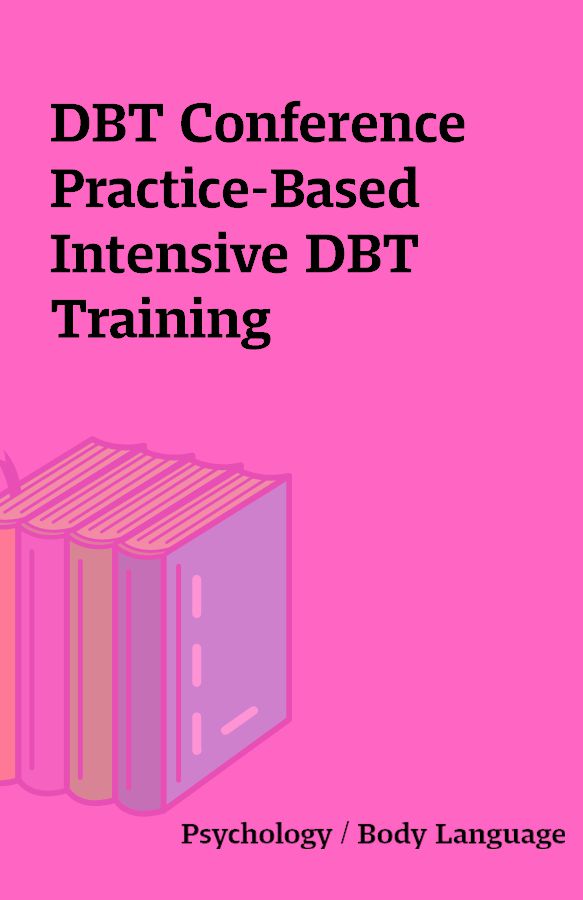DBT Conference Practice-Based Intensive DBT Training
DBT Therapy Conference Practice-Based Intensive DBT Training
[12 MP4] [1 PDF]
Description
***************************************************************Marsha Linehan Mega DBT Training Group Buy YEt another set of the Marsha Linehan Mega GB Project.Sharing it outside is absolutely forbidden *************************************************************** Dialectical Behavior Therapy Conference: Practice-Based Intensive DBT Training12 DVDs, 21 hours 55 mins with electronic manual & instructions.LANE PEDERSON, PSY.D.DBT has evolved from the go-to treatment for borderline personality disorder to one of the most recognized and sought after therapies for a variety of difficult to treat client problems. The increasing pressure to adopt treatments that work makes DBT skills and strategies a must-have for all types of therapists.This conference will teach you DBT from theory to application with up-to-date, accessible teaching and experiential exercises that emphasize evidence-based practice and therapeutic factors rather than rote adherence to a manual.In this seminar recording, therapists of all levels will learn DBT essentials to integrate into your own practice, to confidently practice from a DBT orientation, and to continue their own personal development as a DBT therapist.Grounding DBT into the contextual model of therapy, author and international speaker Lane Pederson, Psy.D., LP, DBTC will show you how to customize this empirically supported treatment across settings and populations to make it work for you and your clients.objectives:Developing the FoundationDescribe DBT from the contextual model of therapy Evaluate DBT research in light of the contextual model and the Evidence-Based Practice of Psychology (EBPP) Connect DBT philosophies and interventions to the therapeutic factors that most improve outcomes Explain dialectic philosophies and their application in therapy Demonstrate how the core assumptions of DBT are put into action Explain how DBT theory drives interventions Develop the fluid movement between validation and change strategies Integrate mindfulness into therapy (and your own life) Implement an effective therapy structure that includes identifying clear treatment targetsSkills Training Effectively integrate skills training into therapy Identify teaching strategies for skills training sessions Effectively teach the 4 standard DBT skills modules Explain and teach supplemental DBT skills and modules Practice skills training techniques in small groups Describe how to seamlessly integrate skills into individual therapyDBT Therapy Summarize DBT from cognitive-behavioral, client-centered, and other approaches Practice a multi-layered approach to validation Balance validation with the most effective (and practical) methods of behavior change Practice reciprocal and irreverent communication styles Demonstrate the key differences between traditional cognitive interventions and DBT-style cognitive interventions Practice therapy techniques with effective pacing, balance, and flow Determine when to use (and not to use) exposure techniquesManaging Challenging Behaviors Master DBT diary cards and chain (change) analysis Effectively participate with consultative groups and treatment teams Assess and manage self-injurious and suicidal behaviors with clear protocols and safety plans Establish clear plans for hospitalizations Establish a plan for your further development as a DBT therapist Describe how you will use DBT in your practiceOutline:Developing the Foundation Essentials of DBT Explicit focus on validation Cognitive-behavioral change strategies Dialectical balance Skills training Mindfulness Consultative approach DBT and the Contextual Model Understanding how therapy works Six decades of empirical research E vidence-based practice Maximizing therapeutic factors, DBT-style Dialectics in Practice Dialectics explained Dialectic assumptions Dialectics in action Core Assumptions of DBT Acceptance and nonjudgmental stance View of clients, therapists, and therapy What’s needed in a DBT clinical process Biosocial Model Biosocial theory of difficulties How theory drives therapy Mindfulness and DBT Mindfulness explained Mindfulness of the approach Mindfulness as a therapy technique Mindfulness in life Getting Started: Structuring Therapy Structure as a therapeutic factor Structuring the therapy environment Identifying treatment targets: suicidality, self-injurious behavior (SIB), therapy-interfering behavior (TIB), and other targets Making It Practical: Structuring Your Therapy or ProgramSkills Training Skills Training Integrating skills into therapy Using skills to develop new behaviors Mindfulness: The Path to Wise Mind What skills: observe describe, participate How skills: nonjudgmental, one-mindful, effectively Mindfulness practice and application Teaching Dialectics Identify dialectical dilemmas Activate Wise Mind action Distress Tolerance Wise mind ACCEPTS IMPROVE the Moment Pros and cons Radical Acceptance/turning the mind Emotion Regulation Model of Emotions PLEASED Build positive experiences Opposite action Interpersonal Effectiveness FAST skills GIVE skills DEAR MAN skills Other Skill Modules Boundaries Problem-solvingDBT Therapy Validation Multi-layered approach to validation Validation as an exposure technique Balance of validation and change Change Interventions Behavioral principals Contingency procedures Best behavior change methods DBT-style cognitive interventions Exposure Techniques When to use (and not to use) E xposure protocols Alternatives to exposure Communication styles Reciprocal IrreverentManaging Challenging Behaviors Diary Cards: Standard and Adapted Behavior Chain (Change) Analysis Getting the client on board Build awareness and options Consultative Group and Treatment Teams Increase your motivation Develop effective responses Qualities of effective treatment teams Assess and Manage Self-Injurious Behavior (SIB) SIB assessment techniques When is SIB life-threatening? Creating alternatives Assess and Manage Suicidal Ideation (SI) Suicide assessment techniques Establishing safety protocols Safety plans and safety commitments Hospitalization Issues Effective use of the hospital Transitions in and out Next Steps What you learned and what you need Developing your plan Taking actionhttps://www.pesi.com/ECommerce/ItemDetails.aspx?ResourceCode… Downloads: Donors; Ratio freeOthers: As per elib rulesThnx to all who made this GB happenEnjoy
You must be logged in to post a review.






Reviews
There are no reviews yet.